Fun Facts
Scientific Name: Physeter macrocephalus
| Kindom | Animalia |
| Phylum | Chordata |
| Class | Mammalia |
| Order | Artiodactyla |
| Infraorder | Cetacea |
| Suborder | Odontoceti |
| Family | Physeteridae |
| Genus | Physeter |
| Species | Macrocephalus |
| Kindom | Animalia |
| Phylum | Chordata |
| Class | Mammalia |
| Order | Artiodactyla |
| Infraorder | Cetacea |
| Suborder | Odontoceti |
| Family | Physeteridae |
| Genus | Physeter |
| Species | Macrocephalus |
What’s in a name?
Physeter (Greek) means blowpipe, or blowhole of a whale
Macrocephalus (Latinized from Greek) means big-headed
Common Names
Sperm Whale. As the most commonly used name for this whale in the English language, the nomenclature stems from the abbreviation of the word spermaceti. For many years, the abundance of an oily, waxy substance found within the head of the whale was mistakenly identified as semen, thus giving birth to the wildly inaccurate name.
Cachalot. This descriptor derives from archaic French and translates to ‘big-teeth’, and may also be linked to Spanish and/or Portuguese languages where it means ‘big head’.

Basic Anatomy
Body
Sperm whales are shaped like torpedoes. Their bodies resemble an elongated cylinder consisting of a large, blunt, squared off head with a small, underslung jaw at the front end followed by a long midsection, and punctuated by a tapered posterior that flares to form their flukes. The large head comprises up to ⅓ of the total body length and more than 1/3 of the mass of the whale. Their dark, gray-brown bodies have a wrinkled, shriveled appearance that begins behind the head and extends along the torso.
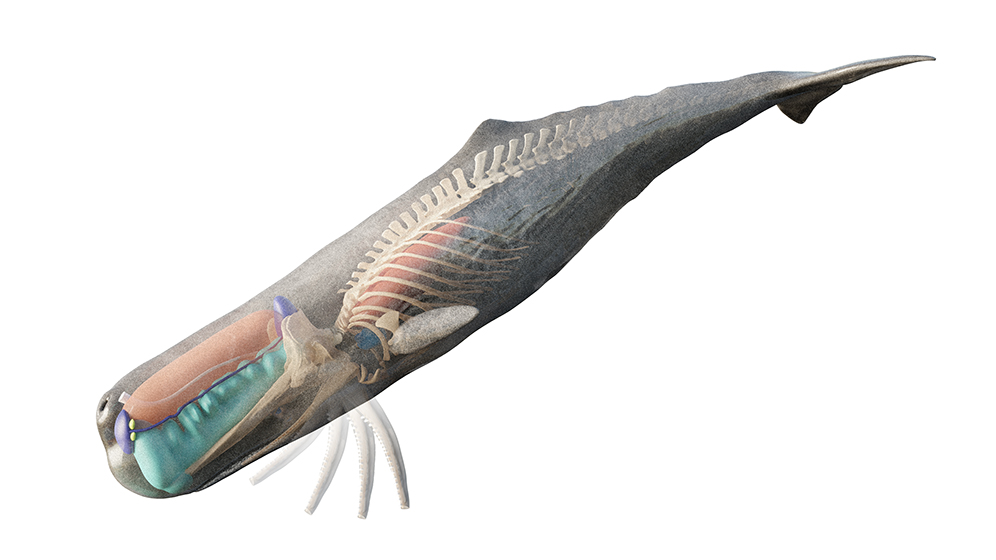
Blowhole
When viewed from the front, the head of the sperm whale is asymmetrical. They possess a single blowhole that is located on the front, left side of the head forming a left-angled single nostril. When they exhale, the blow projects forward rather than straight up as it does with other whales, and the spray forms a bushy, oval shape.
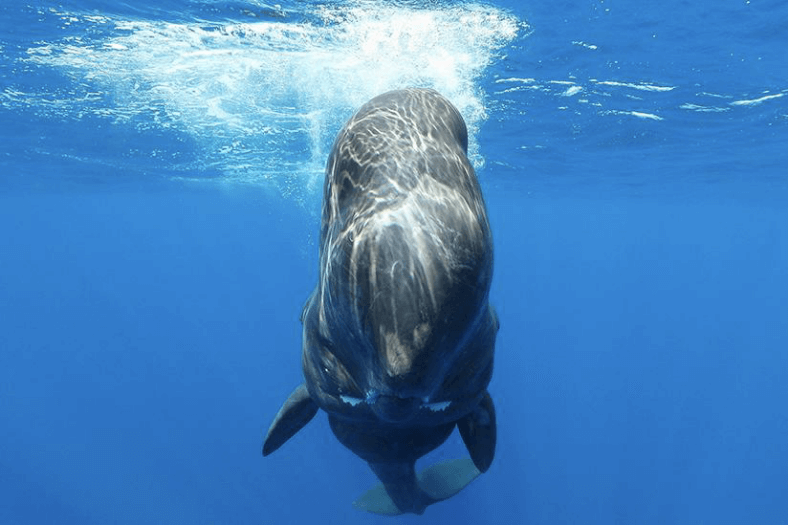
Eyes
Sperm whales can retract or protrude their eyes, but must tilt their heads to the side to view a desired target. While they use their eyes to look intently at one another and subjects of interest, they rely more on echolocation to navigate and interact with the world around them.
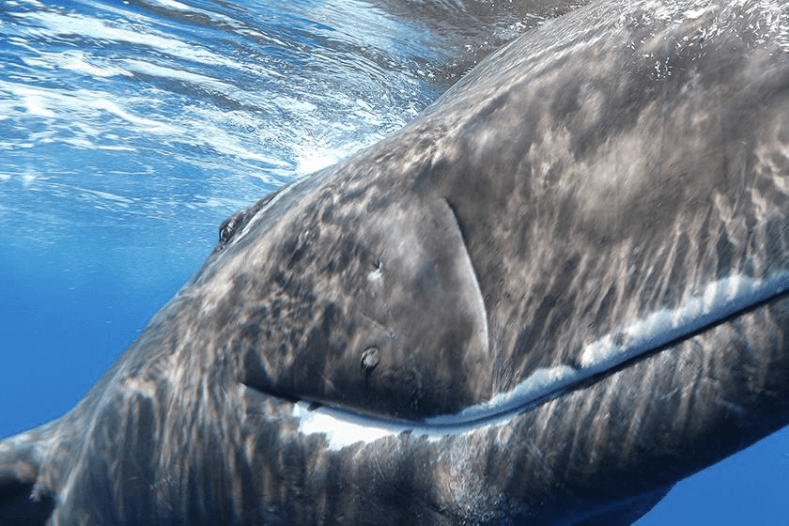
Mouth, Jaws and Teeth
Sperm whales have a long, narrow lower jaw. The area around the mouth, lips and lower jaw is mostly white and forms a distinctive contrast against the dark, gray-brown background of the bulbous head. There are splashes and spots of dark pigmentation along the lips that create a pattern unique to each individual whale.
The white coloration of the lips is thought to assist the whales when hunting for squid in the dark ocean depths. Most species of squid are attracted to light, and it is possible that the sperm whales’ lips are host to phosphorescent bacteria that create light to entice their prey.
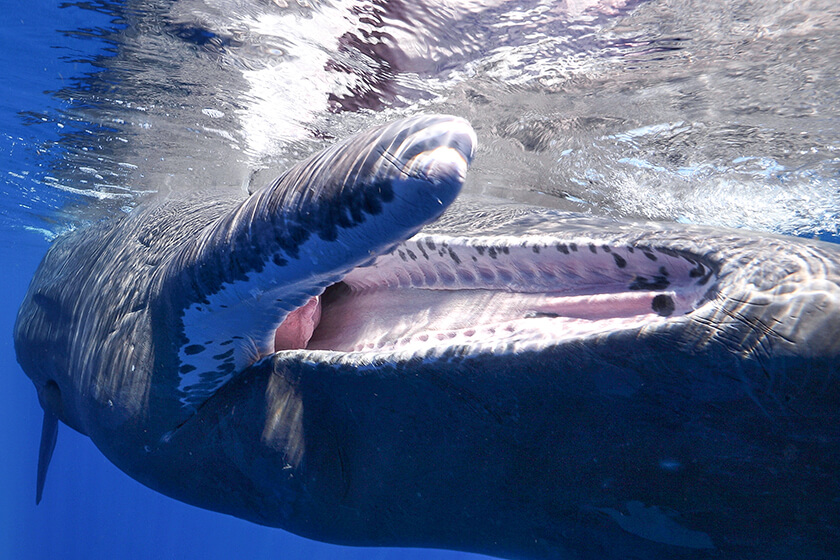
The teeth of sperm whales are conical and very strong, but are only found in the lower jaw. They possess 18 – 25 pairs of large teeth measuring between 3 – 8 inches, (growing to 10 inches in old males). The teeth rest within depressions in the upper jaw, fitting snugly into a series of sockets along the underside of the palate. The jaws and conical teeth appear to be designed for grasping and disabling slippery prey such as squid.
It takes many years for their teeth to grow from rounded bumps into the sharper pointed teeth seen in adult whales.
Dorsal and Pectoral Fins, and Flukes
The fins on sperm whales are rather indistinct compared to other whales. The pectoral fins are surprisingly small, rounded and slightly tapered. The dorsal fin is short, squat and rounded, and is not much later than the series of knuckles that protrude along the whale’s spine between the dorsal and the peduncle.
The flukes are broad but are not proportionately as wide as those of a humpback whale. The flukes of females measure about 8 ft across, and males can reach 16 ft (5 m) from tip to tip. Sperm whales are identifiable by irregularities on the edges of the flukes.
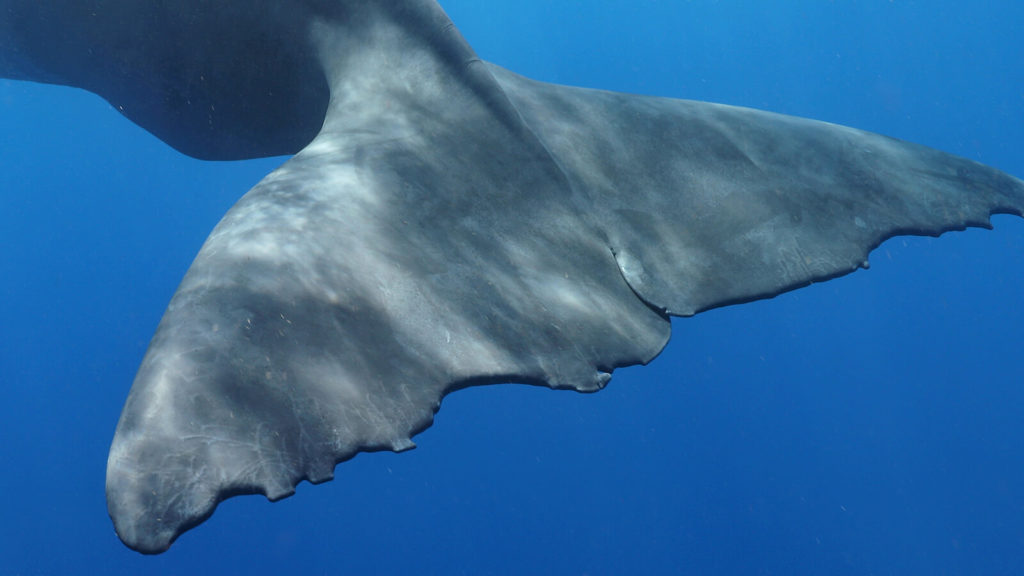
Size Differences in Males and Females
Sperm whales are among the most sexually dimorphic creatures in the animal kingdom.
Males
Length : 49- 59 ft (15 – 18 m) up to 68 ft
Weight : 35 – 45 metric tons (70, 000 – 90,000+ lbs/ 31,750 – 40,800 kgs)
Males are 30 – 50% longer than females, and weigh 3X mass of females, reaching full size at approximately 50 years old.
The head makes up ⅓ of body length (in a large male, measuring 20 ft from nostril to eye), and can weigh up to ten tons.
Females
Length: 35 – 40 ft (11 – 12 m)
Weight: 13- 15 metric tons (31 – 33,000 lbs/ 12,000-12,700 kg), reaching full maturity at 30 years old and 35 ft length
Newborns
Length: 11 – 16 ft (3.4 – 4.9 m)
Weight: 1 ton (907 kg)
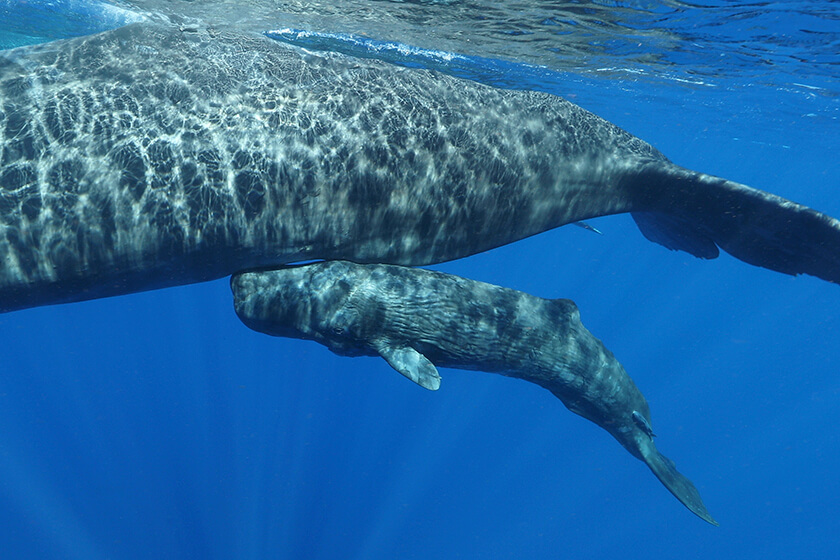
More about Size:
Sperm whales are the largest:
- Odontocete or toothed whale
- Toothed predator
- Deep diver
They possess the largest heads and brains on Earth.
Their brains are five times heavier than a human’s, weighing in at about 17 – 20 lbs.
Their massive hearts weigh about 275 lbs.
They are the only great whale with teeth.
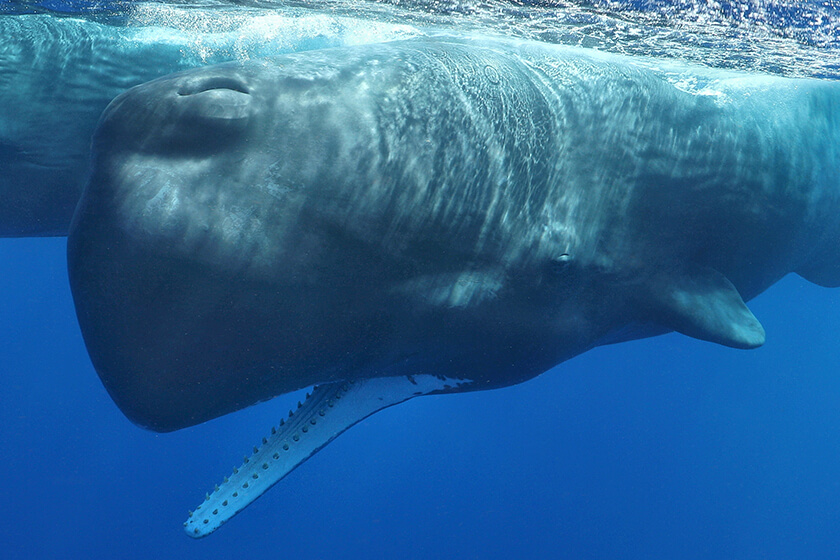
Lifespan
Sperm whales have a lifespan similar to humans, and live to be 70 – 80 years old.
Diving Capabilities
Their average dive is 40 – 50 minutes in duration, but they can dive for up to 90 minutes.
They routinely hunt for food at depths of 3,000 – 6,000 ft, (1000 – 2,000 m).
Dominica’s sperm whales hunt in areas deeper than 6,000 ft, (2,000 m).
Scientists have recorded sperm whale dives up to 7,380 ft (2250 m).
A deepwater shark found at 10, 465 ft, (3,190 m) was in male sperm whale’s belly, suggesting that they can and do surpass 10,000 ft.
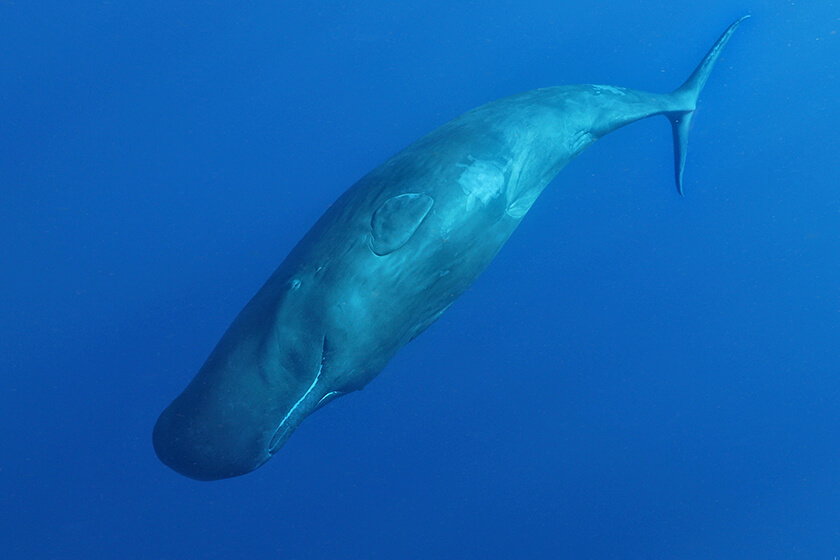
After long, deep dives, individuals recover at the surface for several minutes before initiating their next dive. Their time at the surface correlates with the length of their dives. They are thought to breathe approximately one time for every minute they are at depth. (For example: 50 minute dive = 50 recovery breaths). Adults breathe approximately every 10 – 12 seconds to replenish lungs with air between dives.
Sleep
Sperm whales are among the least sleep-dependent animals on the planet. They spend only 7% of their lives asleep, and do so in a vertical position. Social groups with calves and young whales will typically sleep closer to the surface (between 5 – 25ft) than groups consisting of older members who may slumber 50 – 60ft below the surface.
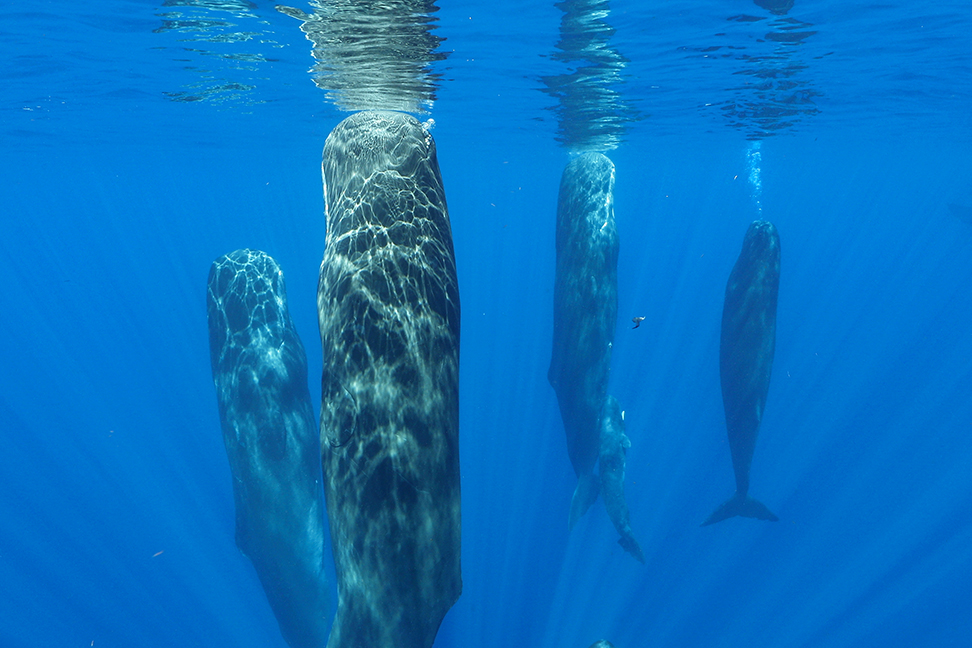
Speed
Cruising speed for sperm whales is roughly between 3 – 9 mph (5 – 15kph) depending on multiple factors including age, size, and gender. Social groups usually cruise at a speed of 4 – 5 mph, a pace which they can maintain for hours at a time. The whales can increase their pace to 22 – 23 mph for about an hour, and may swim as fast as 28mph in shorter bursts if necessary.
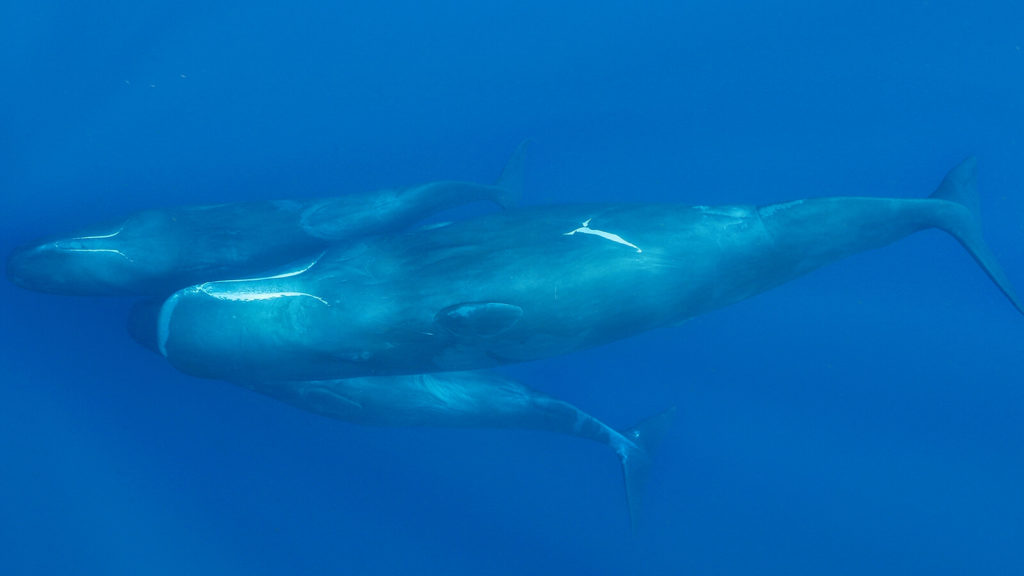
Echolocation and Vocalization
The head of the sperm whale with the inclusion of the spermaceti organ operates as a massive sound generator. The whales produce a wide repertoire of sounds for the purposes of echolocation and sophisticated communication. They are capable of emitting sounds as loud as 230 decibels, which make the sperm whale the loudest animal in the world.
Their echolocation capacity is broadly used for navigating underwater topography, determining the presence, size, and location of other animals, and for hunting. Sperm whales echolocate by emitting a directionally focused beam of broadband clicks. They then receive and interpret the echo or reflection of those sounds to ‘see’ details within their environment.
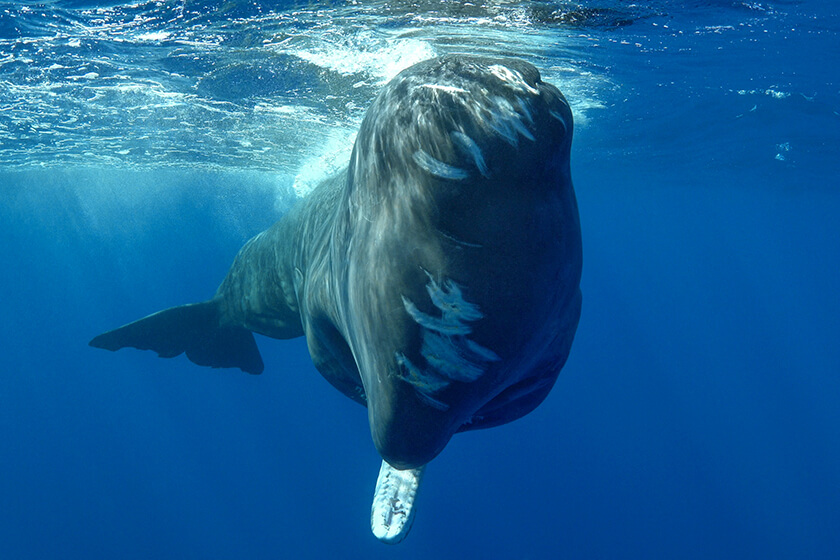
They communicate via specialized vocalizations called clicks, creaks and codas. A creak is produced as a rapid series of high-frequency clicks that literally sounds like a creaky door hinge. Creaks are used when the whales are honing in for closer investigation, and are often heard during periods of socialization.
Codas are distinct, short patterns of 3 to 20 clicks that are used by the whales to differentiate clans, social units, and individuals within the groups. The use of specified codas define the language and dialects of different clans, and serve as an integral component of sperm whale culture.
Hunting, Eating, and Diet
Sperm whales are carnivores who spend 80% of their time engaged in hunting activity. Their food source lives in deep water and consists primarily of squid, but they also eat octopuses, fish, skate, and bioluminescent tunicates. Contrary to popular belief, sperm whales predominantly prey upon small to medium sized squid, and only occasionally eat giant squid. The main staple of the Eastern Caribbean sperm whales is the diamondback squid (measuring 2 – 3 ft long, less than 2 lbs), which make up 95% of their dietary intake.
Sperm whales consume approximately one ton (907 kg) of food each day, and they can eat 3 to 3.5 percent of their body weight per day. The global sperm whale population consumes around the same biomass of food from the oceans as humans eat each year. Fortunately their deep sea squid diet is not currently targeted by humans as an essential food source, so they pose no direct competition.
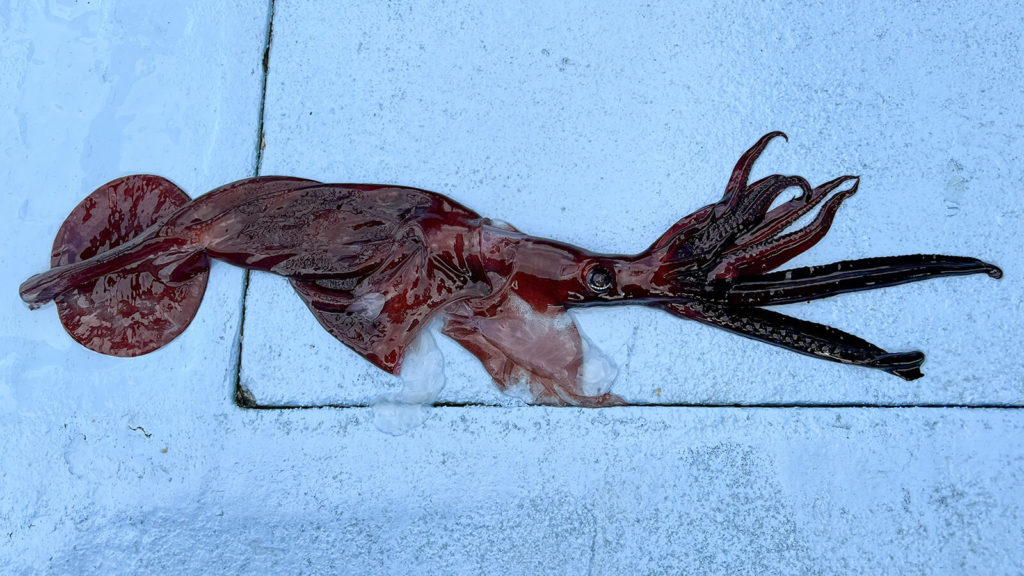
Defecating and Fertilizing
Whales support the marine ecosystem and by extension the entire ecosystem. Their defecation process brings organic material from the deep ocean to water at the surface where it is exposed to sunlight. Iron and other nutrients are deposited into sunlit water by way of plumes of liquid feces excreted by whales.
Drifting phytoplankton feed and flourish on nutrients and sunlight to form the first rung on the ocean food ladder. In addition to being a nutritious food source for small fish, phytoplankton soak up carbon dioxide, thus playing a major role in the carbon cycle by reducing greenhouse gasses on a global scale.
Due to their size, abundance, and worldwide distribution, sperm whales are major contributors to this life-sustaining process. They eat and defecate profusely, and they do so daily unlike many of the migratory baleen whales.
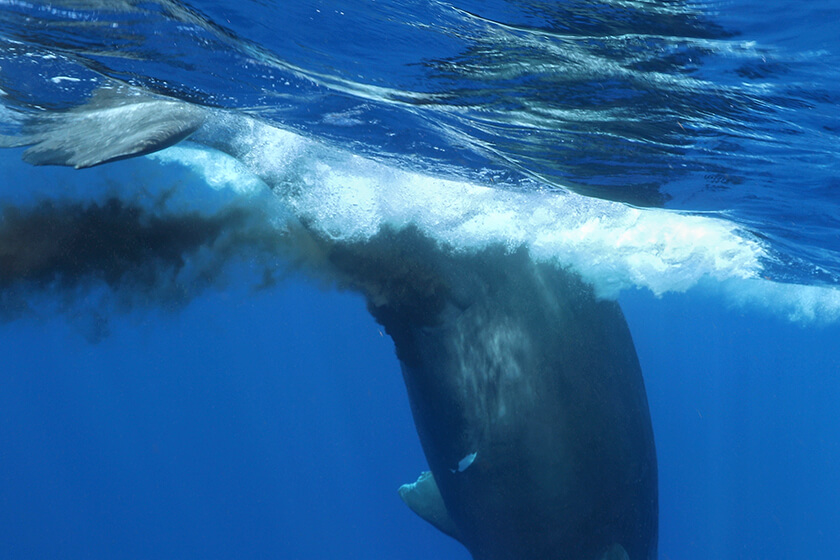
Vomiting ‘Floating Gold’
Sperm whales vomit to release most indigestible matter from their systems, and other undigested substances are naturally passed through fecal excretion. However, some indigestible material inevitably gets lodged in their stomach or intestines. One such material is a squid beak, which can result in the production of an extremely valuable substance called Ambergris (French for gray amber), which is a setting agent for perfume.
Ambergris is formed as a biological response to irritation in the lower intestines of sperm whales caused by an accumulation of squid beaks. The hard, stiff beaks are composed of chitin and proteins that are difficult to digest. Sperm whales consume several thousand squid each day and while the beaks typically pass through their system without issue, some occasionally embed in the stomach and intestines.
Over the period of a few years, the beaks become coated by a secretion from the bile duct to create the solid, waxy substance known as Ambergris. Eventually this substance is vomited by the whales or excreted through their fecal matter to float on the surface of the ocean in lumps of various shapes and sizes which sometimes wash to shore. Clumps have been found weighing .5 ounces to well over 100 lbs.
Ambergris has been used by humans for centuries to create and set perfume, and continues to be highly valuable. As recently as February 2021, a group of Yemeni fishermen found 280 lbs. (127kg) of ambergris which they sold for over 1.3 million US dollars.
Distribution and Migration/Range
Sperm whales are pelagic mammals who reside in water deeper than 3,000 ft. and are found in all oceans of the world.
Adult males spend the majority of their lives in the higher latitudes (past 60 degrees North and South latitudes), preferring ice-free water. They occasionally migrate toward lower latitudes for the purpose of mating, but only the largest mature males appear to enter breeding grounds close to the equator. Adult males can travel 40 mi/day, and up to 20K miles annually.
Females, calves, and juveniles live in more localized social units and remain in the lower latitudes (up to 40 degrees North and South latitudes) year round. They reside in the warmer tropical and subtropical waters of the Pacific, Atlantic, and Indian Oceans. Movement varies among clans, but female social groups can travel over ranges spanning 620 – 930 miles in a given year. Males leave the social units at puberty at 10 – 12 years of age to make their way to the colder water of the higher latitudes.
The global population is unknown but is estimated to be approximately 360,000 sperm whales worldwide, making them among the most abundant of the great whales.
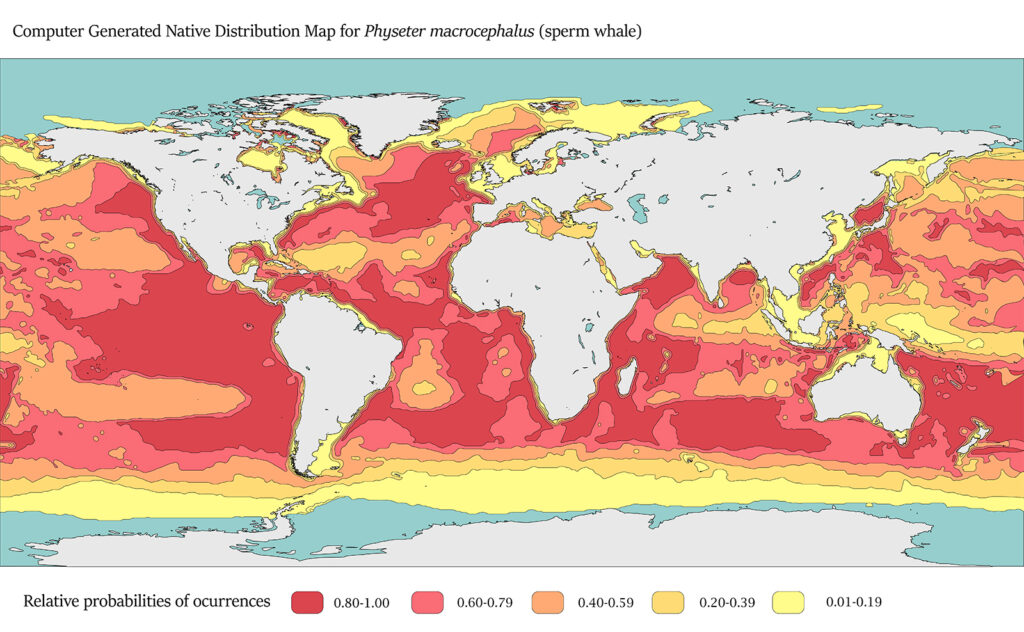
Predators
Orcas pose the greatest natural threat to sperm whales and are most likely to attack females and calves.
Pilot whales and false killer whales are slos known to harass them but are rarely considered to be serious threats.
Threats
- Ship or vessel strikes can injure and kill sperm whales and are most likely to occur when the whales are rafting at the surface or sleeping near to the surface.
- Entanglement in fishing nets can suffocate the whales, and/or compromise their ability to hunt, travel, or protect themselves.
- Chemical pollution, noise pollution, and plastic debris pose a serious threat to their health and survival.
- Hunting. Japan, and Norway still hunt sperm whales.
Species Conservation Status
IUCN sperm whale conservation status : Vulnerable United States
Endangered Species Act : endangered



